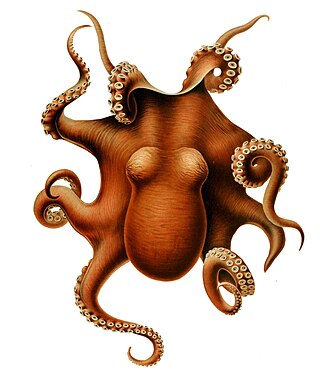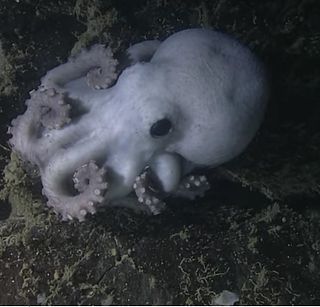
Bigfin squids are a group of rarely seen cephalopods with a distinctive morphology. They are placed in the genus Magnapinna and family Magnapinnidae. Although the family was described only from larval, paralarval, and juvenile specimens, numerous video observations of much larger squid with similar morphology are assumed to be adult specimens of the same family.

Grimpoteuthis is a genus of pelagic cirrate (finned) octopods known as the dumbo octopuses. The name "dumbo" originates from their resemblance to the title character of Disney's 1941 film Dumbo, having two prominent ear-like fins which extend from the mantle above each eye. There are 17 species recognized in the genus. Prey include crustaceans, bivalves, worms and copepods. The average life span of various Grimpoteuthis species is 3 to 5 years.

Taningia danae, the Dana octopus squid, is a species of squid in the family Octopoteuthidae. It is one of the largest known squid species, reaching a mantle length of 1.7 m (5.6 ft) and total length of 2.3 m (7.5 ft). The largest known specimen, a mature female, weighed 161.4 kg (356 lb).[nb a]

Magnapinna atlantica, previously known as "Magnapinna sp. A", is a species of bigfin squid known from only two specimens collected in the northern Atlantic Ocean. It is characterised by several unique morphological features: the tentacle bases are narrower than adjacent arm bases, the proximal tentacle lacks suckers but possesses glandular structures, and the animal's pigment is contained mostly in functional chromatophores.
Moroteuthopsis longimana, also known as the giant warty squid or longarm octopus squid, is a large species of hooked squid. It attains a mantle length of at least 85 cm and probably over 1.15 m. The largest complete specimen of this species, measuring 2.3 m in total length, was found in Antarctica in 2000.

Pareledone is a genus of octopuses in the family Megaleledonidae.
Thaumeledone is a genus of octopuses in the family Octopodidae found in deep waters in the Southern Hemisphere.

Histioteuthis bonnellii, the umbrella squid, is a species of cock-eyed squid belonging to the family Histioteuthidae.

Muusoctopus levis is a species of octopus in the family Enteroctopodidae. It was first described by William Evans Hoyle in 1885 in an article in the Annals and Magazine of Natural History detailing the new species of octopus found on HMS Challenger as part of the Challenger expedition; the type specimen was retrieved from the Southern Ocean. The species is found in subantarctic waters in the Southern Ocean, particularly surrounding Heard Island and Kerguelen Island, but specimens comparable to M. levis have also been found at the Antarctic Peninsula.
Thaumeledone gunteri is a species of small, benthic, deep-sea octopus found in the bathyal zone in the Southern Ocean near South Georgia.

Teuthowenia megalops, sometimes known as the Atlantic cranch squid, is a species of glass squid from the subarctic and temperate waters of the northern Atlantic Ocean. They are moderately sized squid with a maximum mantle length of 40 cm (16 in). Their very large eyes are the source for the specific name megalops. Like other members of the genus Teuthowenia, they are easily recognizable by the presence of three bioluminescent organs (photophores) on their eyeballs.

Louise Allcock is a British researcher, best known for her work on ecology and evolution of the cephalopods of the Southern Ocean and deep sea. She is the editor of the Zoological Journal of the Linnean Society.

Megaleledonidae is a family of octopuses in the superfamily Octopodoidea. It was formerly placed in the family Octopodidae sensu lato as the subfamily Megaleledoninae but more recent studies have raised this taxon as a valid family. Megaleledonidae contains about 43 species in 12 genera.
Bathypurpurata is a genus of incirrate octopus in the family Megaleledonidae from the Antarctic Ocean. The genus has only one species, Bathypurpurata profunda, a small purple octopus which lacks an ink sac and has a single row of suckers and a very large salivary gland. It was described in 2005 from a type specimen caught between the Antarctic Peninsula and the South Shetland Islands.

Muusoctopus is a cosmopolitan genus of deep-sea octopus from the family Enteroctopodidae. These are small to medium-sized octopuses which lack an ink sac. Recent work has suggested that these octopuses originated in the North Atlantic and subsequently moved into the North Pacific while the species in the Southern Hemisphere are descended from multiple invasions from northern oceans.
Nototeuthis is a monotypic genus of squid, in the family Neoteuthidae. The only species in this genus is Nototeuthis dimegacotyle . This species is characterised by short tentacular clubs, less than 40% of the length of the mantle, and relatively long fins, which are approximately 60% of the mantle length. The tentacle clubs have two greatly enlarged suckers on distal portion of the manus, which distinguish N. dimegacotyle from other members of the Neoteuthidae. Few specimens of this species are currently known. Specimens have been collected from the south eastern Pacific Ocean, off Chile, between the Southern Subtropical and the Antarctic Polar frontal zones. This species is mesopelagic to bathypelagic and can be found from near the surface to a depth of ~500m.

Cirrothauma magna, also known as the big-eye jellyhead, is a species of deep-sea cirrate octopus that has been found in the Indian, Atlantic, and Pacific oceans. It is known from four damaged specimens. Their shells are somewhat saddle-shaped. C. magna is the sister taxon of Cirrothauma murrayi, but can be readily distinguished by having large and well developed eyes.
Grimpoteuthis challengeri is a species of large octopus living in the abyssal zone.
Opisthoteuthis philipii is an octopus of the Indian Ocean. It lives off the coast of Kerala, India. Known specimens were found between 275–365 m (902–1,198 ft) deep in the Arabian Sea near Alappuzha.
Opisthoteuthis robsoni, also known as the deep-water umbrella octopus, is a deep-sea octopus living off New Zealand on the Chatham Rise. It has been found from 1,178–1,723 m (3,865–5,653 ft) below the surface. Not much is known about the octopus' habitat or life cycle, as only four specimens have been found. It occupies the benthic zone, or the seafloor and the water directly above it. O. robsoni eats large amphipods.










